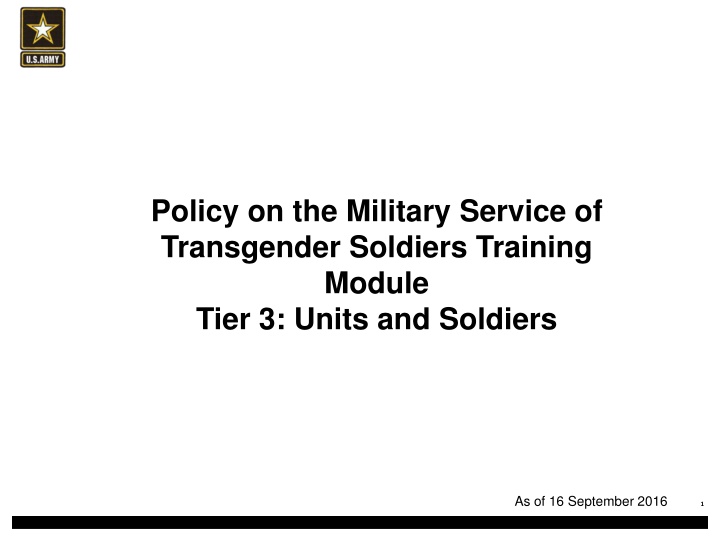
Transgender Service Policy in the Army - Training Module Overview
Learn about the Department of Defense and Army policy allowing open service of transgender Soldiers, their rights, responsibilities, and the process involved. Understand how the Army supports transgender Soldiers while upholding military standards and respect for all service members.
Download Presentation

Please find below an Image/Link to download the presentation.
The content on the website is provided AS IS for your information and personal use only. It may not be sold, licensed, or shared on other websites without obtaining consent from the author. If you encounter any issues during the download, it is possible that the publisher has removed the file from their server.
You are allowed to download the files provided on this website for personal or commercial use, subject to the condition that they are used lawfully. All files are the property of their respective owners.
The content on the website is provided AS IS for your information and personal use only. It may not be sold, licensed, or shared on other websites without obtaining consent from the author.
E N D
Presentation Transcript
Policy on the Military Service of Transgender Soldiers Training Module Tier 3: Units and Soldiers As of 16 September 2016 1
Our mission is to defend this country, and we dont want barriers unrelated to a person s qualification to serve preventing us from recruiting or retaining the Soldier, Sailor, Airman, or Marine who can best accomplish the mission. We have to have access to 100 percent of America s population for our all-volunteer force to be able to recruit from among them the most highly qualified and to retain them Starting today: Otherwise qualified Service Members can no longer be involuntarily separated, discharged, or denied reenlistment or continuation of service just for being transgender. Secretary of Defense Ash Carter, June 30, 2016 2 UNCLASSIFIED
Purpose This module provides training on Department of Defense and Army policy allowing open service of transgender Soldiers, and an overview of roles, responsibilities and associated processes. 3 UNCLASSIFIED
Transgender Service Policy The Army allows transgender Soldiers to serve openly The Army is open to all who can meet the standards for military service and remains committed to treating all Soldiers with dignity and respect while ensuring good order and discipline All Soldiers must maintain Army standards, good order and discipline at all times Transgender Soldiers are subject to the same standards as any other Soldier with the same DEERS gender marker An otherwise qualified Soldier shall not be involuntarily separated, discharged, or denied reenlistment or continuation of service on the basis of gender identity Ensure all Soldiers are treated with dignity and respect at all times 4 UNCLASSIFIED
Gender Transition in the Army Gender Transition Complete: an administrative status indicating that a Soldier has completed the medical care necessary to achieve stability in the preferred gender. The medical care is the medical process identified or approved by a military medical provider in a documented medical treatment plan. The care required to transition is individualized and often does not include surgical treatment. Transition complete is an administrative status and does not preclude future medically necessary treatment. Gender Marker Change: Once gender transition is complete and the Soldier s gender marker in DEERS is changed, the Soldier is expected to adhere to all military standards associated with the Soldier s gender marker in DEERS and use billeting, bathroom, and shower facilities in accordance with the DEERS gender marker Soldiers will comport to the standards associated with their gender marker in DEERS. 5 UNCLASSIFIED
Prohibition of Harassment and Discrimination AllSoldiers are entitled to equal opportunity in an environment free from harassment, including sexual harassment and unlawful discrimination based on sex (gender identity) The chain of command is the primary and preferred channel to identify and correct discriminatory practices with the assistance of the Equal Opportunity Advisor. The chain of command will process and resolve complaints and ensure that EO matters are taken seriously and acted on Commanders and all Soldiers must maintain good order and discipline within the ranks. Violations of EO policies may result in disciplinary actions under the UCMJ EO policies apply to working, living, and recreational environment (on and off-post, during duty and non-duty hours) 6 UNCLASSIFIED
Terms Gender identity. One s internal or personal sense of being male or female Gender dysphoria.A medical diagnosis that refers to distress that some transgender individuals experience due to a mismatch between their gender and their sex assigned at birth Medically necessary. Those health care services or supplies necessary to prevent, diagnose, or treat and illness, injury, condition, disease, or its symptoms and that meet accepted standards of medicine Real life experience. The phase in the gender transition process when the individual commences living socially in the gender role consistent with their preferred gender. This will generally occur in an off-duty status and away from the Soldier s place of duty prior to the change of the gender marker in DEERS Preferred gender. The gender of Soldier when gender transition is complete and the gender marker in DEERS is changed Gender marker. Data element in the Defense Enrollment Eligibility Reporting System (DEERS) that identifies a Service member s gender 7 UNCLASSIFIED
Terms Cont. Transgender Soldier. A Soldier who has received a medical diagnosis indicating that gender transition is medically necessary, including any Soldier who intends to begin transition, is undergoing transition, or has completed transition and is stable in the preferred gender Gender transition process. Gender transition in the Army begins when a Soldier receives a diagnosis from a military medical provider indicating that the Soldier s gender transition is medically necessary, and concludes when the Soldier s gender marker in DEERS is changed and the member is recognized in the preferred gender Stable in preferred gender. Medical care identified or approved by a military medical provider in a documented medical treatment plan is complete, no functional limitations or complications persist, and the individual is not experiencing clinically significant distress or impairment in social, occupational, or other important areas of functioning. Continuing medical care, including but not limited to cross-sex hormone therapy, may be required to maintain a state of stability 8 UNCLASSIFIED
Roles and Responsibilities Transgender Soldier: Initiate process, maintain individual readiness and meets Army standards throughout the transition process Military Medical Providers: Providediagnosis, develop treatment plan, confirm medical treatment plan complete and provide medical treatment Commander: Maintain unit readiness, support the Soldier, and approve timing of medical treatment plan, and approve gender marker change upon submission of completed request Army Service Central Coordination Cell (SCCC): HQDA organization comprised of medical, legal, and military personnel experts, to serve as a resource for commanders and process requests for exceptions to Army standards Policy, guidance, and sample memos are available on milSuite at: https://www.milsuite.mil/book/groups/army-transgender- service-information/overview Source: Army Directive 2016-35, Enclosure 1, (7 October 2016) 9 UNCLASSIFIED
Transitioning Soldier Responsibilities Initiates process, maintains individual readiness, and meets Army standards o Seeks a medical diagnosis (or confirmation of a civilian diagnosis) from a military medical provider (MMP) o Notifies immediate commander (CDR) o Works with military medical treatment team (MTT) to develop a medical treatment plan (MTP) o Works with the commander and MTT to refine timing of the treatment plan o Works with commander to set conditions which support MTP o After medical treatment plan is complete, submits request through brigade level commander for gender change in DEERS o Maintains standards during and after gender transition IAW gender marker. o Uses the billeting, bathroom, and shower facilities associated with their gender marker in DEERS Soldiers who identify as transgender should seek assistance from their military medical provider For RC Soldiers using a civilian medical provider, diagnosis and treatment plan will be subject to validation by a military medical provider 10 UNCLASSIFIED
Vignette 1: No Diagnosis of Gender Dysphoria Considerations and Responsibilities: Vignette: A Soldier in your unit tells everyone that although he was born male, he identifies as a female. He explains that he is beginning the process of transitioning from male to female. 1. Treat Soldier with dignity and respect. 2. Soldier chose to discuss the transition with his colleagues and will likely be open to sincere and respectful questions about the process. Use good judgment in asking personal questions, as you would with any other Soldier. 3. Understand that DoD and Army policy allow transgender Soldiers to serve openly and provides a process for Soldiers to transition while serving in the military. Gender transition in the Army begins when a Soldier receives a diagnosis from a military medical provider indicating that the Soldier s gender transition is medically necessary, and concludes when the Soldier s gender marker in DEERS is changed and the member is recognized in the preferred gender. 11
Vignette 2: Real Life Experience Off Duty Considerations and Responsibilities: Vignette: A Soldier in your unit is transitioning from male to female. As part of the medical treatment plan, the Soldier dresses as a female (real life experience) off-duty. You were not aware that the Soldier is transitioning to a female. You see the Soldier in a bar wearing a dress and make- up. 1. Treat Soldier with dignity and respect. 2. Understand that gender transition may include social, medical, and legal components. Social transition, in the military context, will generally encompass living in the preferred gender after duty hours. 3. Some individuals prefer that no one knows they are transitioning, while others may want to discuss it openly. 4. Respect your colleague s privacy. If the Soldier does not want anyone to know that he is transitioning, do not out the Soldier to other members in the unit. 5. Treat the Soldier as you would like to be treated. 12
Vignette 3: Soldier Transitioning to Preferred Gender Considerations and Responsibilities: Vignette: A Soldier in your unit is transitioning from male to female. As part of the medical treatment plan, the Soldier is taking cross-hormone therapy and voice therapy. About four months into the medical treatment, the Soldier s body and voice begin to visibly change. 1. Treat Soldier with dignity and respect. 2. Understand that gender transition may include social, medical, and legal components. Medical treatment may include behavioral health care, use of hormones (which may change physical appearance), and/or surgery. 3. Intervene if you witness other Soldiers harassing or bullying the transgender Soldier. 4. Treat the Soldier as you would like to be treated. 13
Vignette 4: Soldier/Unit Training Barracks, Bathrooms, and Showers Vignette: Considerations and Responsibilities: Following her transition from male to female (which did not include sex reassignment surgery) and gender marker change in DEERS, a transgender Soldier begins using female barracks, bathroom, and shower facilities. Because she did not undergo a surgical change, the Soldier still has male genitalia. 1. Treat all Soldiers with dignity and respect. 2. Soldiers must accept living and working conditions that are often austere, primitive, and characterized by little or no privacy. 3. All Soldiers must use the barracks, bathroom, and shower facilities associated with their gender marker in DEERS. 4. Understand that you may encounter individuals in barracks, bathrooms, or shower facilities with physical characteristics of the opposite sex despite having the same gender marker in DEERS. 5. All Soldiers should be respectful of the privacy and modesty concerns of others. However, transgender Soldiers are not required or expected to modify or adjust their behavior based on the fact that they do not match other Soldiers. 6. Soldiers should discuss any questions or concerns with their chain of command. Soldiers must use the barracks, bathroom, and shower facilities associated with their gender marker in DEERS. 14






















